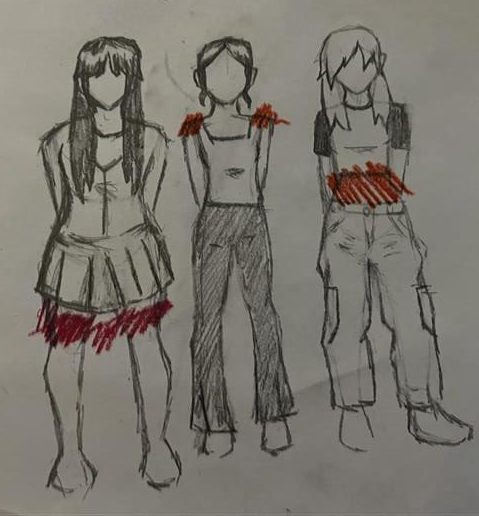Did you know that 27% of Harrison students have been dress coded? This may seem like a small amount, however, what if I told you that out of that 27%, more than 94% of people dress coded were girls?
So, does this mean that boys just happen to be more abiding to the school’s dress code, or is it specifically targeted towards girls? An even bigger question is, are these seemingly biased rules rooted in misogyny and the over-sexualization of women?
Many believe that a key function of dress codes is to control students’ behavior and promote conformity. Researchers at ACLU believe that the way these codes are primarily targeted towards girls “may reflect the sexist and harmful view that girls’ bodies are inherently vulgar or inappropriate.”
Many young girls growing up have been taught to “cover up” to prevent the boys from becoming distracted, and this idea is only further implemented at school. Girls may feel that they are responsible for creating a learning environment free from distractions, and likewise getting punished by the school for revealing parts of their body deemed ‘distracting.’ On the other hand, the men, who were never taught that their predatory behavior within the school is what is truly inappropriate, are portrayed as the victims in this scenario.
Directing this issue back to our school itself, we should establish what the dress code of our school actually is. In the 2024-2025 student handbook 6 dress code rules were established:
“1. Clothing and accessories that could be interpreted as promoting hate or communicating a negative, profane, or vulgar message are not permitted. Additionally, jewelry and accessories that pose a safety concern for the student or others are not acceptable.”
I think we can all agree that this is a fairly reasonable rule, and, in my opinion if something is a physical safety hazard, making sure that no one gets injured is important. Along with clothing that promotes controversial and inappropriate things should also be monitored. Unfortunately, I don’t think the school even takes these into consideration, because I’ve seen people wear problematic shirts with no consequences.
“2. Undergarments should not be visible. Tops that expose the midriff or chest, tank tops, mesh tops, and shirts with no sleeves are not acceptable. Pants, shorts and skirts must be worn at the waist level.”
This one is definitely a more controversial rule, because I’ve noticed that this isn’t abided by everyone. I’ve seen teachers wear sleeveless shirts and as for the undergarments rule, girl’s bra straps are seen as much more of an issue then guys sagging their pants to the point their boxers are completely showing.
“3. No head coverings (hats, bandanas, hoods, etc.), or gloves should be worn during the school day.
- No oversized coats are permitted during the school day.
- Shorts, skirts, and dresses should not reach a length that is overly revealing.”
Another comment I would like to make on rule 5 is how vague it is. There is no definition to what is considered “overly revealing”.
“6. Footwear should be safe for the learning environment.”
In the handbook, the reasons given for these rules are as follows:
“Building administration has the discretion to require students to change their clothing or remove any accessories that cause a distraction or disruption to the educational environment.”
When asked if anyone’s fashion choices had been a distraction to the learning environment, 94% percent of Harrison Students said no, which could easily be proof that maybe the intentions of creating a distraction free environment aren’t the true purpose of the code and is instead used as a form of control and objectification.
While I understand there has to be a line somewhere when choosing what to wear for school, (someone showing up in swimsuits wouldn’t be acceptable) there shouldn’t be anything wrong with shirts that show a small amount of skin on the stomach, or where shoulders are showing. There is nothing inherently sexual about shoulders. It is quite literally the joint that connects your arms to your torso. If a grown adult perceives the body parts of an underage girl to be something sexual and distracting, then there is a much bigger issue and that says a lot about them as a person.
When asked what she would like to share about the way our schools dress code was implemented, Student Emerson Bunner responded with and important point.
| “Girls are disproportionately targeted by dress codes compared to boys, revealing the misogynistic roots of these policies. Additionally, girls with fuller figures—such as larger chests or hips—are more frequently dress coded, even when they’re wearing the same outfits as those with smaller bodies,” Bunner says.
“This often leads to a sense of objectification, as if their worth is tied to their appearance rather than their personhood. Furthermore, in all my conversations, no one has ever been distracted by the clothing I or anyone else wears. The only people who seem to take issue with what we wear are often older men, which is deeply troubling and perpetuates harmful societal norms.” |
For more background about these questions, we have to discuss the beginning of the dress code. Dress codes have been around for centuries, but the first major challenge of them was established in 1969 by the U.S. Supreme Court. The case, known as Tinker vs. Des Moines Independent School District, prohibited students from wearing black armbands as a form of protest towards the Vietnam War. As a result, the court did in fact rule in favor of the students and deemed that schools may not limit the power of student expression as a way to prevent disruption to the learning environment. However, this case only applied to political statements made on clothes and did not regulate the actual types of clothing worn, such as the length of skirts. While my opinion on this issue might not affect the school’s policy or the way it’s enforced, I believe that it is necessary to spread awareness how even today the normalization of this misogynistic mindset may reflect the expectations placed on women and the way a predominantly patriarchal society views them.



























